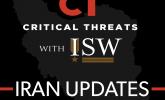October 8, 2023 - ISW Press
Russia advanced legal mechanisms to reform the Leningrad Military District as part of ongoing large-scale military reforms. The Russian federal portal of draft regulatory legal acts published a presidential decree on October 8, prepared by the Russian Ministry of Defense (MoD), which proposes stripping the Northern Fleet (NF) of its status as an “interspecific strategic territorial association.” Russian state media noted that the proposal indicates that the NF will no longer be a separate military-administrative unit equal to a military district, suggesting that the NF and its four constituent regions (The Komi Republic, Arkhangelsk, and Murmansk oblasts, and the Nenets Autonomous Okrug) will be transferred to the reformed Leningrad Military District. Russian military analyst Yuri Fedorov noted that the recreation of the Leningrad Military District suggests that Russia is preparing for possible conflicts with Baltic states and NATO. The Russian military merged the Moscow and Leningrad Military Districts into the Western Military District in 2010. The MoD created the Northern Fleet in 2014 out of territory covered by the Western Military District, and Russian President Vladimir Putin made the NF a military-administrative unit equal to a military district starting January 1, 2021. Russian Defense Minister Sergei Shoigu proposed the recreation of the Moscow and Leningrad Military Districts on the basis of the Western Military District (reversing the 2010 and 2014 changes) in December of 2022, and confirmed that these military districts were under active formation as of August 2023. The MoD’s decision to re-divide the WMD indicates Russia sees the need to restructure its forces facing NATO and likely posture on the Finnish border, although it remains unclear how Russia will be able to mobilize, train, and organize these forces into new military district-level formations.











